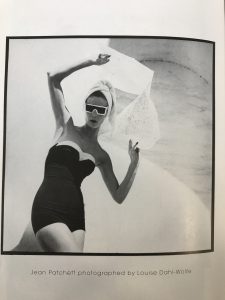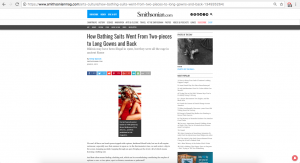The image that I chose to research is a photograph of Jean Patchett, a leading model in the 40’s and 50’s , I found in the book ‘Top Model’ by Michael Gross (published in 1995), taken by fashion photographer Louise Dahl-Wolfe in 1953 in Grenada. The image depicts Jean in a black and white swimsuit in the style popular at the time, with graphic sunglasses to match and her hair wrapped in a towel. Searching online for similar images I came across a photo of what appears to be the front cover of ‘Vogue Paris’ from June 1952. The model (unknown) is sporting a swimsuit practically identical in style to the one Jean Patchett is wearing in Louise Dahl-Wolfe’s photograph of her; strapless with shorts and a sweetheart neckline. The fact that this particular style of swimsuit was on the cover of ‘Vogue Paris’ in June 1952 is evidence that this was the “it” swimsuit style of that year, and the fact that Jean Patchett was wearing the same style a year later in 1953 solidifies that this style of swimsuit was set
, I found in the book ‘Top Model’ by Michael Gross (published in 1995), taken by fashion photographer Louise Dahl-Wolfe in 1953 in Grenada. The image depicts Jean in a black and white swimsuit in the style popular at the time, with graphic sunglasses to match and her hair wrapped in a towel. Searching online for similar images I came across a photo of what appears to be the front cover of ‘Vogue Paris’ from June 1952. The model (unknown) is sporting a swimsuit practically identical in style to the one Jean Patchett is wearing in Louise Dahl-Wolfe’s photograph of her; strapless with shorts and a sweetheart neckline. The fact that this particular style of swimsuit was on the cover of ‘Vogue Paris’ in June 1952 is evidence that this was the “it” swimsuit style of that year, and the fact that Jean Patchett was wearing the same style a year later in 1953 solidifies that this style of swimsuit was set  to stay throughout the 50’s.
to stay throughout the 50’s.
I then found more information on Louise Dahl-Wolfe from the summary of an exhibition documenting her life and work on the Fashion and Textile Design Museum’s website. On here I learnt of her important role as a female fashion photographer in a field largely dominated by men, and how she captured the independence of the post-war woman in her photography. She worked largely with Harper’s Bazaar from 1936 to 1958, her ties to the fashion industry and fashion magazines meaning she would have most likely come across the edition of ‘Vogue Paris’ displaying the popular swimsuit style she would photograph Jean Patchett in a year later. After reading an article on the ‘Elle Magazine’ website I learnt that in the early 50’s many beaches across Europe attempted to ban bikinis, which were becoming popular in the post-war years as women were shedding the regimented dress of wartime and celebrated their freedom. As a result of the ban, the higher coverage swimsuits came back into fashion, examples of which can be seen in both of my chosen images.
However, they were nowhere near as modest as the “bathing gowns” that were introduced in the 17th century, as I read on www.smithsonianmag.com, the first purpose-made bathing garments being made out of stiff, yellow canvas. Modesty was of the utmost importance in the centuries that followed, swimwear being made out of heavy, opaque fabrics such as wool and flannel and in designs made to disguise the female figure rather than accentuate it. It wasn’t until the early 20th century that more figure-hugging swimwear came into fashion and slowly more and more skin became exposed, culminating in 1946 when French engineer Louis Réard designed what we recognise today as the bikini. His risqué design caused wide-spread controversy and was not an instant hit, the preferred swimwear for the 50’s being the more modest one-piece displayed in my initial picture and on the cover of ‘Vogue Paris’. However, the bikini eventually took off until it became the popular piece of swimwear we see on beaches all over the world today.
- M. Gross, (1995), ‘Top Model: Les Secrets d’un Sale Business’, Paris: A Contrario
- Vogue Paris Cover, 1952. Available from: https://www.pinterest.co.uk/pin/173036810654278891 (accessed: 22/10/17)
- Emily Spivack, (2012), Smithsonian.com. Available from: https://www.smithsonianmag.com/arts-culture/how-bathing-suits-went-from-two-pieces-to-long-gowns-and-back-134926264/ (accessed: 22/10/17)
